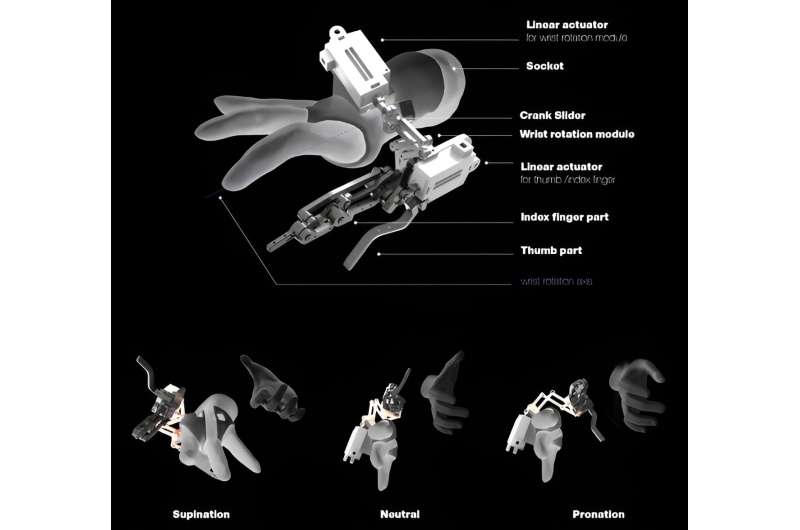This article has been reviewed according to Science X's editorial process and policies. Editors have highlighted the following attributes while ensuring the content's credibility:
fact-checked
trusted source
proofread
A wrist-rotatable robot for a renewed lease on life in partial hand amputees

A Korean company recently garnered attention by showcasing robotic prostheses and artificial limbs to 50 recipients. These robotic assistive devices play a crucial role in supporting the daily activities of individuals with congenital disabilities or those who have experienced unfortunate accidents. Despite their benefits, achieving truly natural movements remains a significant challenge for these robotic assistive devices.
Professor Keehoon Kim from the Department of Mechanical Engineering and the School of Convergence Science and Technology and Dr. Seoyoung Choi, a research fellow from the Department of Mechanical Engineering at Pohang University of Science and Technology (POSTECH), have made a noteworthy contribution to addressing this challenge.
They have successfully integrated a wrist rotation module into a robotic prosthesis, allowing for more natural movements without straining the user's body. The results of their research have been published in the Journal of NeuroEngineering and Rehabilitation.
Prosthetic hands serve as new hands for individuals with partial hand amputations. Traditional prosthetics, while designed to replace the affected area, often have limitations in wrist movement capabilities. This lack of flexibility prevents patients from freely moving their wrists, leading to the adoption of compensatory behaviors and increased strain on the arm and upper body.
In response to this issue, the research team has developed an innovative prosthetic hand tailored for a patient who lost their thumb and index finger in a car accident.
This advanced prosthesis operates by interpreting signals to the muscles through sensors and determining the motion intention. Unlike conventional prosthetics, it incorporates a wrist rotation module, enabling patients to enjoy unrestricted movement of their wrists.
The research team conducted an analysis of the muscle synergies in the arm and upper body associated with the newly-developed prosthesis, the conventional prosthesis, and those of individuals without prosthetics.
By using electromyographic signals and a motion capture system to assess arm and upper body muscle activity, the researchers identified statistically significant differences in reaching and grasping movements between the newly designed and existing prosthetic hands.
The findings revealed that while using a conventional prosthesis, shoulder and upper body movements were approximately 260% higher than normal, indicating an unnatural wrist rotation and resulting in the overuse of the arms and upper body.
In contrast, the prosthesis developed by the research team facilitated a restoration to normal levels of upper body movements, allowing for efficient and natural gestures without causing secondary damage to the musculoskeletal system. Notably, the team's prosthetic hand exhibited over a 30% improvement in hand function compared to a traditional prosthetic hand.
Professor Keehoon Kim who led the research explained, "It is necessary to adopt an integrated approach in the development of robotic assistive devices, considering not only the replacement of a specific body part but also the interconnected components."
He further remarked, "We aim for robotic prosthetics to be both safe and durable, ultimately restoring the lives that users may have lost."
More information: Seoyoung Choi et al, Restoring natural upper limb movement through a wrist prosthetic module for partial hand amputees, Journal of NeuroEngineering and Rehabilitation (2023). DOI: 10.1186/s12984-023-01259-9





















